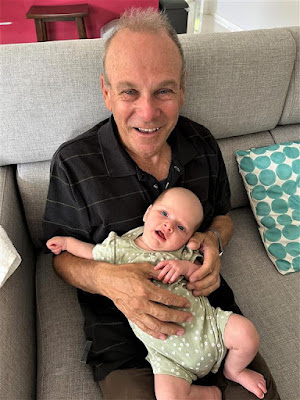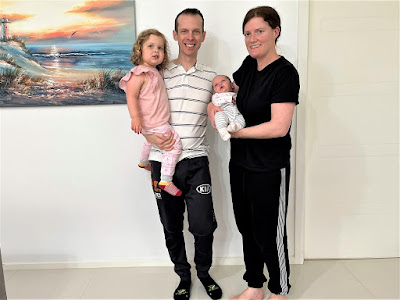Entry 18 – South Australia to Canberra – drive
time - November 2021.
We had
researched several options for overnight stopovers along our planned route for
our planned week of drive time from our current location on the South
Australian Yorke Peninsular to the Australian capital of Canberra. We were
about to start our first planned days itinerary when it came to our attention
it was a close friend 65th birthday whom lived along our planned
route. We got on the phone and yes, he was having a small gathering with family
and friends that night. Yes, it would be wonderful if we could make it. We
fitted in two days of planned driving into one and enjoyed a great night of
socialising.
We stayed
two nights with John and Kathy, immensely enjoying their company.
We crossed
the border leaving our home state of South Australia on the 15th
November and immediately felt vulnerable as the proposed border re-opening date
when we would be permitted back into South Australia didn’t commence until the
23rd November.
We
travelled from Renmark in South Australia to Balranald in New South Wales, our
first nights stop over. The impact on travel caused by the covid-19 pandemic
was extraordinarily evident. The roads in this area of Victoria and New South
Wales were the most deserted we had ever experienced. It was an eerie feeling
travelling along near deserted roads, normally busy with traffic. The primary
vehicles sighted, the transport road trains moving goods around Australia. It
was rare to see another caravan or motorhome. With nearly 300 kilometres covered
over the day we suspect we would have barely seen about one dozen caravans/motorhomes
in total. Normally there would be hundreds. Even solo cars were absent
considering these are the primary vehicles we see travelling these routes. On a
positive, the quiet roads assisted with the ease in which road trains could
pass us without the need to slow down, waiting for a safe gap in the oncoming
vehicles.


It’s rare
to spot wild life when travelling these routes. We spotted several mobs of emus
enjoying some poor farmers crops prior to harvesting.
We had
initially thought a few nights at one of Balranald’s nearby national parks on
the banks of the Murrumbidgee River felt appealing. We
had last stayed at this location in 2018 finding to be a beautiful, quiet and
peaceful environment. The below picture from our 2018 camp site.
Unfortunately,
the dirt entry road into the national park was closed to vehicles. We parked at
the nearby historic Yanga Woolshed and walked towards the camp site for a personal
closer inspection. The river level was high lapping at the top of its banks. We
couldn’t get near the campground due to it being surrounded by water. We
certainly didn’t want to get bogged whilst on foot.
With most
of the bush settings around the town of Balranald effected by high levels of water,
making it unsafe to drive onto we re-assessed our options. We stayed one night
at Balranald parked up on a bitumized carpark and continued down the road a bit
to the town of Hay.
Travelling
across the Hay plain is quite boring. Occasionally you might see some sheep but
mostly it is nothingness. It was even duller than normal with the absence of
other vehicles due to the covid-19 pandemic.

At one
stage as we were getting closer to Hay with the nearby Murrumbidgee River, we
were attempting to get a picture of some large irrigation activities. These
pictures are obtained by the passenger when in motion whilst the driver just
concentrates on the driving. In this instance the second picture shown was of
the front of a transport road train travelling in the opposite direction,
unsighted by the photographer at the time as they were concentrating on the
irrigation equipment in the paddock. The transport road train with its 60 ton
something loads, travelling at 100 kph and us in the opposite direction at
about 90 kph = a point of impact at 190 kph if one of us moved onto the wrong
side of the road. What a scary thought and is why our driver just drives. This
also reiterated to us the importance of keeping the driver fresh and alert,
where we regularly share the driving chores swapping before the driver gets
tired.


We set camp
at one of Hay’s free camp areas next to the Murrumbidgee River the 3rd longest river in
Australia about 1,500 kilometres long. Its water level the highest we had ever
seen.
We walked
about, along some walking trails set up around Hay and toured one of Hay’s 18th
century homes, the Bishop’s Lodge Historic house.
After a
couple of days at Hay we continued down the road to the township of Narrandera,
setting camp at its Brewery Flats free camping area. Once we were set up,
(deciding where we should park) we walked the kilometre or so into town
attending the towns information centre. There was a small foyer and we were
provided with some local information via a small window. Once it was
established, we were double vaccinated for covid-19 we were provided with entry
into their inner sanctum where we were able to obtain more of the type of
information we were seeking.
Our entry
experience at the information centre was a sign of things to come with the
latest government initiative requiring people to provide proof they were fully
vaccinated for covid-19 prior to being granted entry.
We
initially walked around town admiring some of the town’s older buildings.
The
following morning, we were up early walking the publicised flora and fauna
reserve trail with the advertised possibility of spotting some koalas. It was a
lovely picturesque setting and even better when we indeed spotted some koalas. The
area was water logged and hindered our progress around the trail. Though our
spirits were high with our eyes tantalised by beautiful scenery and the koala
spotting was very special.
We enjoyed a
wetland’s walk with several bird hides scattered around its perimeter.
All the
above walks we were able to seek out on foot from our base camp, adding to our
enjoyment. There were a few other options of interest to us but required some
initial drive time to these various areas. When we return to this area, we
would like to allocate more time exploring its offerings. Our strategy for this
trip during stop overs was to utilize our time for some rest and relaxation
between our longish driving days on our way to Canberra. Narrandera seemed like
a proud town with great walking trails, good aquatic park for the locals and
visitors during those hot periods and the Murrumbidgee River.
After a
couple of nights at Narrandera we continued our driving, choosing to deviate
away from the main highways for this day’s travel time. There were a couple of
larger towns, impacted by the covid-19 outbreaks along the highway route which
we chose to avoid.
Travelling
along the less travelled roads of the Australian country side provides a more
interesting outlook of life away from our crowded cities. The progression of
farmers canola crops over the growing season was fascinating. Early September
we had seen paddocks with canola crops covered by vibrant yellow flowers and
now in late November those same canola crops cut and stacked in wind rows waiting
for the correct timing to remove it from the paddocks.
Our final
stopover before arrival day at our target destination of Canberra was at
Jugiong, with a large open area with camping permitted. We set camp on the picturesque
outer edge with a view of the fast-flowing, very full Murrumbidgee River.
Canberra’s
not a huge city by current modern-day times but it still had a population of
462,000 residents, still making it big. Our primary reason for travelling to
Canberra was to be with our son and his family. Due to the ongoing lack of current
appropriate information from our governments dealing with the covid-19 pandemic
we chose to prop just outside of the Australian Capital Region at the smaller
town of Yass to complete our food shop for our following weeks requirements. We
were constantly strategizing with ideas to lessen any possible exposure from
the effects of the pandemic.
We arrived
at our planned destination at a caravan park in Canberra located about six
kilometres from our son’s family home, spending the rest of the day in
preparation for our planned nine days of activities.





















































































